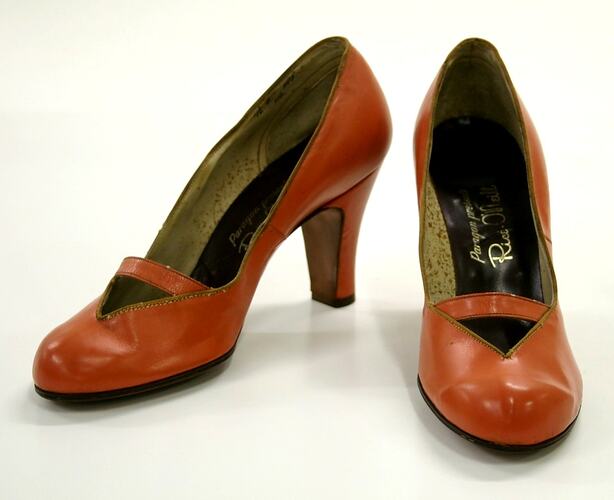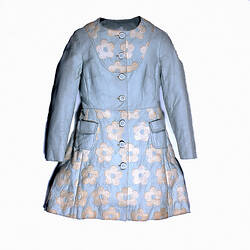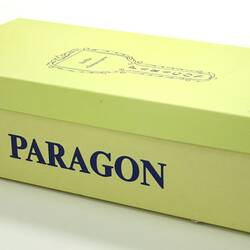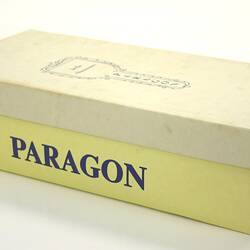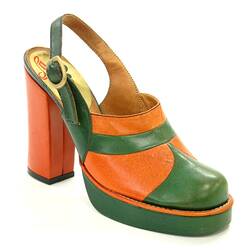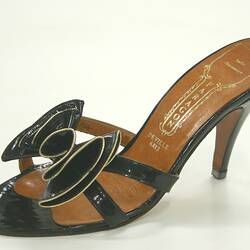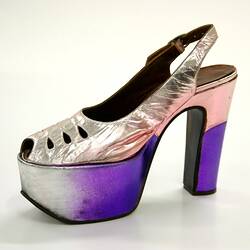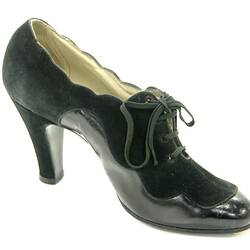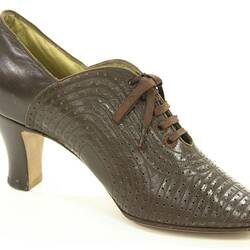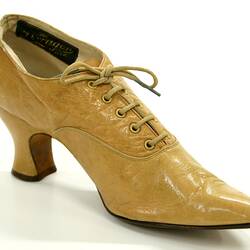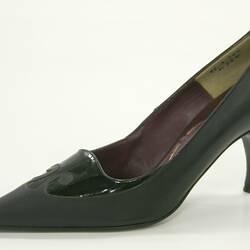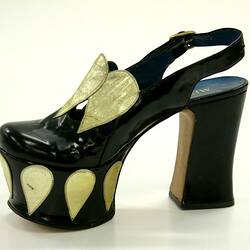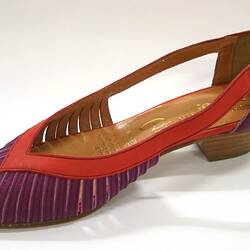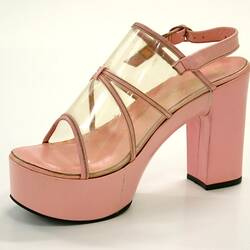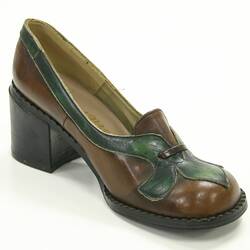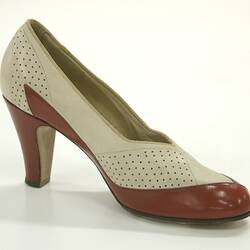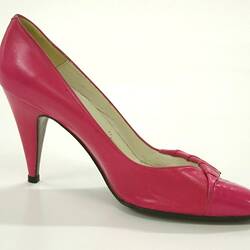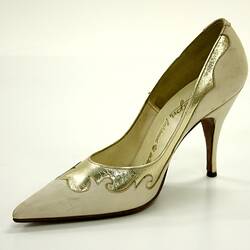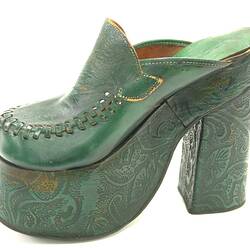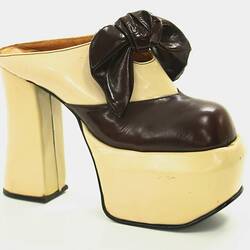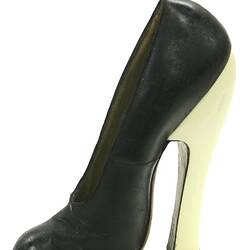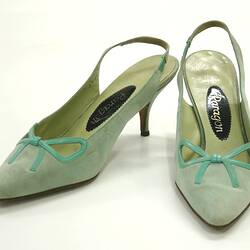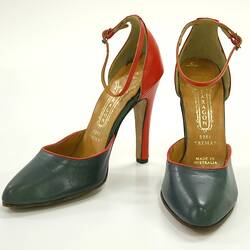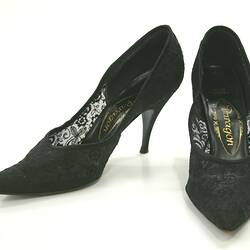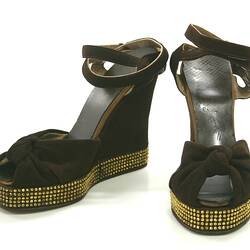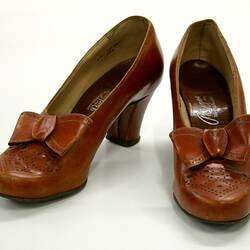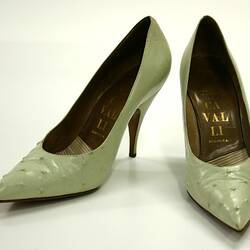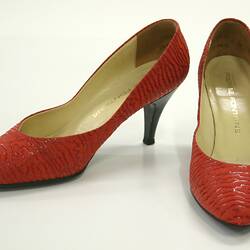The Paragon Shoe Collection comprises 88 objects, largely shoes, as well as advertising and point-of-sale material. The collection dates from circa 1916 to circa 1993. It was donated by Diana Gaze; additional shoes have been donated by Linda Bennett.
Paragon Shoes Pty Ltd was one of the most significant 20th century Australian shoe retailers, and at one time was the largest manufacturer of high quality of women's shoes in Australia. Its factory was located in Melbourne, and its shoes were sold throughout Australia and New Zealand. A London agent was used at one stage, and the shoes possibly sold in Europe (based on the information supplied with the shoes).
The name Paragon was originally used by H. Walters Pty Ltd. Henry Walters founded a boot manufactory in Regents St, Richmond, in 1883 (later listed in Sand & McDougall as 36 Regents St). Henry Walters was born in Stettin, Prussia (now Szczecin, Poland), around 1844, and arrived in Victoria from NSW in 1867. He was naturalized in 1896. Henry married to Margaret Mahoney, an immigrant from Tipperary, Ireland, who came out in 1867 with a guardian (her sister came out the following year). She married Henry in 1869, when she was not yet 21 years old. Their eight children included sons Henry and Herman. Margaret tragically died of cirrhosis of the liver from alcoholism in her 30s, possibly as a result of a struggle with depression.
Walters applied for the 'Paragon' trade mark on 7 August 1905 (trademark vol.17, fol.239, no. 9256). The application stated that 'The word paragon has reference to the character or quality of the goods - meaning a model or example of excellence'. The distinctive Paragon logo is included with the application.
The Paragon name was bought by the donor's father-in-law, Alexander Ambrose Davison (Alec), in 1930, following the death of its founder. Alec Davison, born in 1886, had begun his working life at shoe manufacturer Robert Hurst & Co in North Fitzroy, and later pursued his interest in bookmaking as he worked his way up the shoe manufacturing industry. In his early years he marketed shoes under the name 'A. Davison'. His first company was The House of Stanley, formed in 1920 in partnership with W.H. McFarland (by October 1923 and after a change of partners, he appears to have become a sole director). The House of Stanley first manufactured men's and women's shoes at a shoe factory they bought at 71 Argyle St, Fitzroy, then in 1923 moved to a purpose-built factory at 38-44 Stanley St, Collingwood. The Australian Leather Journal in October 1923 enthusiastically described this single-floor factory as a 'striking example of scientific planning', including a 'modern dust-extraction plant that keeps the air of the factory clean and healthy', 'the latest machinery for high-grade (closing) work' and 'nothing that will help the staff is lacking'. Conditions in the administrative section, however, were perhaps less favourable, suggested in a report prepared by a taxation and accounting consultancy, which reviewed the company's financial position and procedures in 1926-27. It criticized the cramped, uncarpeted office, its 'useless' light, the loss of staff time on 'each dark winter evening' and the 'dirt, noise and drafts' if the office door was left open to the factory. It disparaged Alec's ad-lib management style and casual approach to bookkeeping. Nevertheless, the business went from strength to strength.
The factory was expanded in 1928, almost doubling in size. In November 1930, after the Paragon name was bought from the estate of Herman Walters, Walters' factory was also taken over. In 1931, the business name was changed to Paragon Shoes Pty Ltd. Women's shoes were confirmed as the focus of the business. The factory was further expanded in 1937, and at the opening celebrations a speaker noted that the company now employed 260 people.
The shoes were retailed through a range of outlets. Alec Davison developed an association with retailer Milady's Shoemaker, and Buckley & Nunn also became a large Paragon seller. Paragon shoes were also retailed in many other outlets, including Mabs McQuirk (in Sydney). Alec went into partnership with Miladys and opened two further shops to sell Paragon shoes, including a large shop at the corner of Elizabeth and Collins Streets. Other stores were opened in Collins Street, Toorak and South Yarra.
Alec's son Lex joined the business at the age of 19. He was released from the army because Paragon was manufacturing shoes for the women's services and was considered an essential service. Lex was unhappy about this, but persevered with the company. His father's health deteriorated, and in August 1945 Alec died, leaving Lex to continue the business. The business continued to grow, aided by tariff protection.
Like other footwear and clothing manufacturers, Paragon looked to international fashion trends to develop new designs. Australian seasons were considered to follow those of overseas, rather than the reverse. Shoe samples were ordered or collected by company representatives (including Lex and his wife Diana) from Europe and the United States. Shoe fairs were held in March and September in Milan, Paris, Bologna and Vigevano. Company representatives took surreptitious photographs of shoe shop windows, trying to record new styles. Charts and colour cards were obtained from overseas fashion centres, providing important information such sales figures of particular styles. Advertisements and photographs were cut from magazines and newspapers, and pasted into sketchbooks to formulate new designs. Amongst those who designed shoes and made patterns was Fred Davis, who worked for Paragon in the 1940s and 1950s. He would work out how to make shoes from particular styles, sometimes scaling his designs up or down for different sizes. As many as 40 separate pieces were sometimes needed to make his shoes; and over 100 different steps were involved.
For the first 20 or more years of the business Australian tanned leather was of poor quality and only used for shoe linings, and imported leather was used for the other parts of the shoes. Lex established a tannery in Queensland to supply Paragon, called Donald Dixon, and became a shareholder and director. That business was eventually sold to a Japanese meat company.
In 1960 Lex and Diana went directly to an Italian shoe designer and brought new designs that were not yet popularized by the fashion industry. Although they were trying to lead the fashion industry, the attempt was unsuccessful, since the designs needed to be first popularized by the fashion industry before they were marketed.
Lex was also a racing car driver, and died in a car race at Sandown Park in 1965, at a peak in the Paragon business. John Gilbert, Sales Manager, was promoted to director. Lex's wife (the donor, Diana) also became a director, as did her son Richard (by the age of 21). Other key players in Paragon included Frank Jones and his son. Frank started at Paragon at the age of 14, sweeping floors, then became factory manager under Jack Dunlop, and eventually became a director with company shares.
As fashions changed and new market sectors were pursued, Paragon created new labels for its products. Pierre Fontaine was established in the early 1960s as a cheaper shoe; Parisienne was aimed at the younger buyer; and Belle Chaussure was aimed at a sophisticated buyer. Royal Paragon was made with luxury materials, such as brocades, crocodile or lizard skin. Innovare was made exclusively for Myer. In the early 1970s Paragon bought the Parker label through an arrangement with David Jones. The Parker range had been carried by Georges. In the 1980s Paragon expanded its range to include bags and accessories such as belts. They were initially made at the Stanley Street factory, but later a separate factory was established for this work (and/or it was outsourced to Harry Jibes). Pierre Fontaine shoes were also manufactured at another factory, also in Stanley St, Collingwood, called Trimfoot. Trimfoot had about 100 employees by the early 1970s, and eventually moved to Preston. Paragon sold the Stanley Street factory in the late 1980s and moved to Temple Drive, Thomastown.
After reaching the height of its business in the late 1980s, with 100,000 pairs of shoes produced per year, Paragon closed around 1993. Many pairs of shoes from the business were sold at the Camberwell Market.
The shoes acquired by Museum Victoria were largely made by Paragon, but some were purchased from other manufacturers (including some overseas) to guide new Paragon designs. The donor wore some of the shoes herself; others are unworn. Some were given to her for her shoe collection.
References:
Diana Gaze (previously Davison), pers. comm. with D. Tout-Smith, 2005 & 2009
G. Howard, 2004. Lex Davison: Larger than Life. Turton & Armstrong, Sydney
The Australian Leather Journal, Boot and Shoe Recorder, 15 Oct 1923, p.580; 16 July 1923, p.231; 15 May 1929, pp. 20-22; 15 April 1930, p.1047; 15 December 1930, p.626; 15 February 1933, p.882; 16 October 1933, p.561; 15 March 1934, p. 1067 & 1112; 15 November 1934, p. 219 & p.1112.
The Argus Women's Magazine, 4 April 1950, pp. 8-9.
The Sun, 17 April 1975, p.46
Margaret Leydon (great-granddaughter of Henry Walters), pers. comm. with D. Tout-Smith, 9/1/2010
More Information
-
Keywords
Advertising, Australian Design, Australian Manufacturing Industry, Fashion, Fashion Design, Footwear Accessories, Footwear Industry, Leather Products, Manufacturing, Manufacturing Works, Retailing, Shoes, Women's Footwear
-
Localities
Victoria, Australia, New South Wales, Australia, United States of America, Europe
-
Authors
-
Article types
